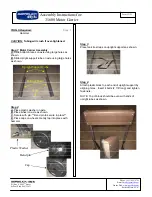A N 6 9 2
24
Rev 0.4
First the radio is in off state. After the SDN pin is pulled low, the radio wakes up and performs a Power on Reset,
which takes a maximum of 5 ms until the chip is ready to receive commands on the SPI bus. GPIO1 pin goes high
when the radio is ready for receiving SPI commands. During the reset period, the radio cannot accept any SPI
command.
There are two ways to determine if the chip is ready to receive SPI commands after a reset event: 1) Use a timer
in the host microcontroller to wait for this period or 2) Connect the GPIO1 pin of the radio to the host MCU and poll
the status of this pin. During the power on reset, the GPIO1 remains in low state. Once the reset is finished, the
radio sets GPIO1 to high state. Next, the radio device has to be sent to active mode by issuing a "POWER_UP"
command via the SPI interface, which takes approximately 5 ms to be completed. This process can be monitored
in three ways: The first option is to poll the CTS over the SPI; the second option is to detect that the radio pulled
down the NIRQ pin, and the third option is to detect that the radio pulled up the GPIO1 pin. Once the device is in
active mode, the host MCU must clear the interrupt flags from the radio.
Summary of Contents for Si4455 Series
Page 8: ...AN692 8 Rev 0 4 Figure 6 Device Configuration Options ...
Page 22: ...AN692 22 Rev 0 4 Figure 21 Supply Current versus Time Diagram from Shutdown to RX State ...
Page 23: ...AN692 Rev 0 4 23 4 4 Radio Chip Waking Up Figure 22 Radio Wake Up Process ...
Page 35: ...AN692 Rev 0 4 35 Figure 32 Transmission Flowchart ...
Page 39: ...AN692 Rev 0 4 39 Figure 33 Reception Flowchart ...
Page 41: ...AN692 Rev 0 4 41 Figure 34 Bidirectional Variable Packet Example Project Flowchart ...
Page 47: ...AN692 Rev 0 4 47 Figure 41 Long Packet Transmission Flowchart ...
Page 48: ...AN692 48 Rev 0 4 Figure 42 Long Packet RX Flowchart ...

















